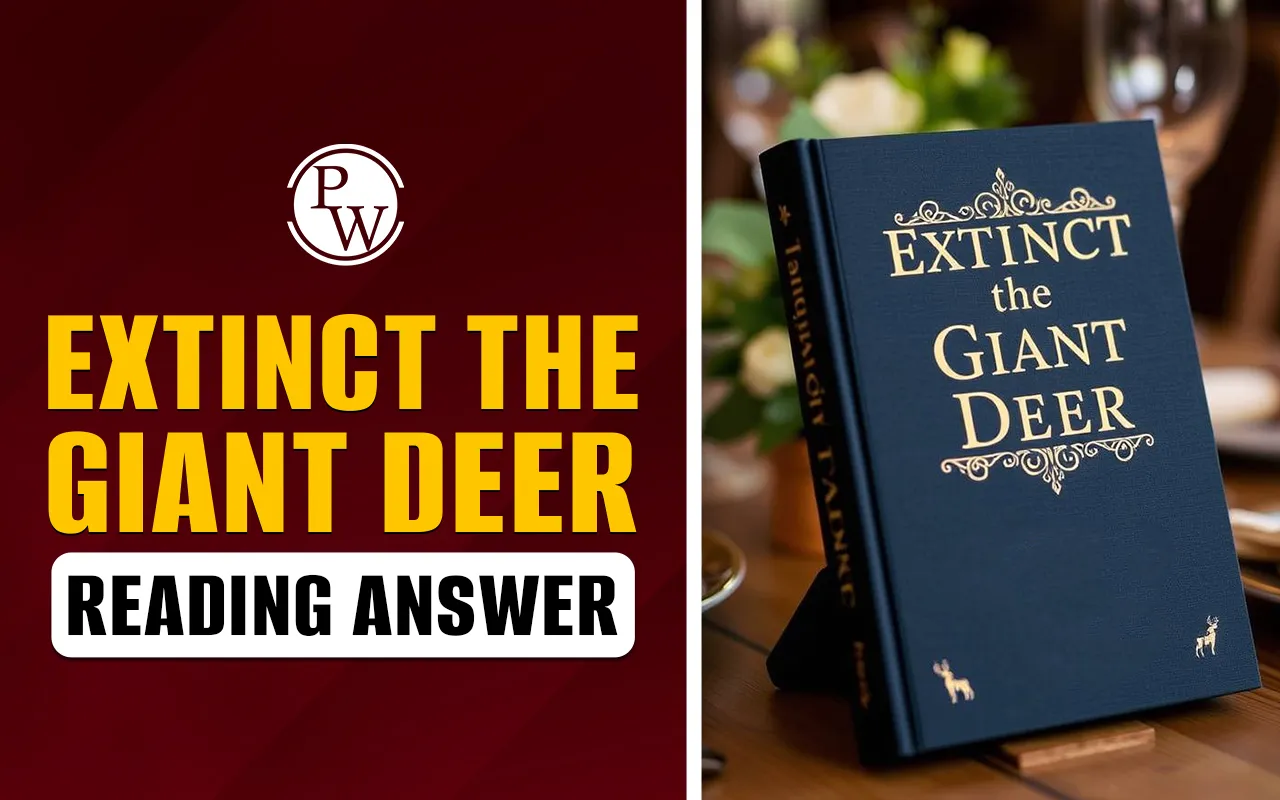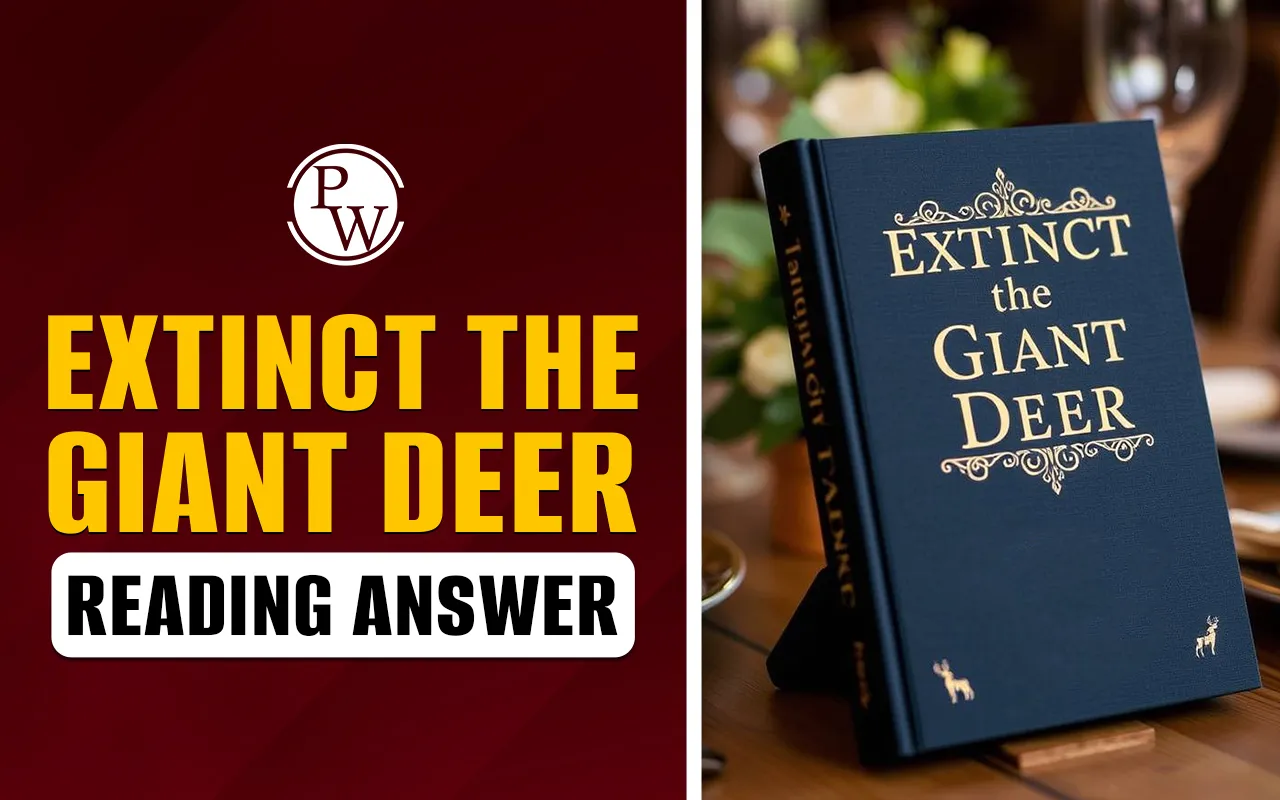

Extinct The Giant Deer Reading Answer: The IELTS Reading section tests candidates’ ability to understand challenging passages under time pressure. The IELTS exam often includes topics based on science or environment for the reading exams. The IELTS reading passage on the Giant deer is an excellent resource for improving preparation. It offers insights into the disappearance of Megaloceros giganteus, also known as the Irish Elk.
Understanding the Extinct giant deer IELTS reading explanation also helps in improving one’s grasp of environmental history and species that decline due to climate change and human activity. This passage also connects candidates to real-world sustainability and conservation discussions.
Free IELTS Reading Practice Tests
Extinct The Giant Deer Reading Answer IELTS Passage
Here is the IELTS reading passage for Extinct giant deer. Candidates should carefully read the passage and highlight key information to quickly answer the related questions.
Extinct The Giant Deer IELTS Passage
Paragraph A
The megaloceros giganteus is otherwise called the Irish elk (giant deer). Studies of decrepit bones and teeth by analysts based in Britain and Russia show the enormous herbivore lived until about 5,000 B.C.—exceeding three renaissances later than formerly trusted. The investigation panel says this hints at more aspects, apart from climate change, probably rushed the Irish elk's final disappearance. The aspects could comprehend hunting or environmental demolition by humans.
Paragraph B
The giant deer, so-called as its well-kept debris are frequently found in lake dregs under morass in Ireland, first emerged about 400,000 years ago in Europe and central Asia. via an amalgamation of carbon-14 dating of skeletal remains and the aligning of spots where the remains were excavated, the crew shows the giant deers was excited across Europe before the last "big freeze." The deer's span later shrinks to the Ural Mountains in present-day Russia, which divided Europe from Asia.
Paragraph C
The Irish elk made its last stand in western Siberia, some 3,000 years after the ice sheets retreated, said the study's co-author, Adrian Lister, lecturer of palaeobiology at University College London, England. "The eastern highlands of the Urals became very thickly forested about 8,000 years ago, which could have pushed them onto the plain," he said. He combined that antigen inquiry to designate the region, then became very parched in reaction to further climate swap, leading to the loss of chief food plants. "In amalgamation with human pressures, this could have eventually extinguished them out," Lister said.
Paragraph D
Stalking by humans has frequently been placed forward as a conducive cause of the destruction of the pleistocene megafauna. The crew, even though, said their new date for the Irish elk's annihilation, clue at an additional human-made issue-environmental demolition. Lister said, "We haven't got just hunting 7,000 years ago-this was also about the time the first Medieval people lived in the region. They were farmers who would have discharged the land." The existence of humans may help describe why the Irish elk was helpless to resilient out the latest of many climatic oscillation-periods it had alive in the past.
Paragraph E
Meanwhile, Lister cast uncertainty on other feasible clarification for the deer's death-the male's vast horn. Some chemists have advised this overemphasised characteristic-the outcome of females preferring stags with the biggest horns, perhaps because they published a male's fitness- donated to the mammal's downfall. They say such horns would have been a serious trouble in the thick forests that spread northward after the last ice age. But, Lister said, " That's a compelling argument to make because the deer formerly survived finely well via wooded glaciation [ a warm period between glacial epochs]." Some analysts have advised that an inadequacy of enough high-quality fodder caused the annihilation of the elk. High amounts of calcium and sodium phosphate compounds are needed to form horns, and therefore, huge quantities of these minerals are needed for the huge structures of the Irish Elk. The males(and male deer in general) met this necessity partly from their bones, refill them from food plants after the horns were developed or recoup the nutrients from discarded horns( as has been noticed in surviving deer). Thus, in the horn growth stage. Irish elk were aching from a condition alike to silent disease. When the climate swapped at the end of the last ice age, the flora in the animal's environment also changed against species that probably could not deliver enough amounts of the needed minerals. At least in the western part of its range.
Paragraph F
The annihilation of megafauna all over the world was almost concluded by the end of the last glacial period. It is trusted that megafauna at first came into continuation in reaction to icy conditions and vanished with the onset of warmer climates. Tropical and subtropical areas have gone through less radical climate swap. The most dramatic of these swaps was the change of a huge area of North Africa into the world's biggest desert. Notably, Africa avoided major faunal annihilation, as did tropical and subtropical Asia. The human evacuation from Africa and our access into the Americans and Australia were also caused by climate change. Australia's climate swapped from cold-dry to warm-dry. As a outcome, surface water becomes scant. Most inland lakes become totally dry or dry in the warmer seasons. Most large, mainly peruse animals lost their environment and retired to a narrow band in eastern Australia, where there was lasting water and better flora. Some animals may have lived until about 7000 years ago. If people have been in Australia for up to 60,000 years, then megafauna must have accompanied humans for at least 30,000 years. Frequently hunted modern kangaroos lived not only 10,000 years of indigenous hunting but also an assault of trade shooters.
Paragraph G
The crew of analysts led by A.J. Stuart concentrated on northern Eurasia, which he was taking as Europe, plus Siberia, basically, where they have got the best data that animals vanished in Europe during the Late pleistocene. Some cold-adapted animals experienced the last part of the cold stage, and then vanished up there. So you have usually got two phases of vanishing. Now, neither of these concur— these are Neanderthals here being replaced by modernised humans. There's no clear accident between the arrival of humans or climatic swap alone and these destruction. There's a climate swap here, so there's a dual effect here. Again, as animals come via to the last part of the icy stage, here there's a basic swap in the climate restructuring of flora, and the amalgamation of the climatic change and the existence. There's a heartfelt variance between the North American data and that of Europe, which abridge that the destruction in northern Eurasia, in Europe, are average and lurch, and in North America, acute and sudden. And these things relate to the variance in the timing of human arrival. The destruction follows from human depredation but only at times of basis swaps in the habitat.
Also Read:
Extinct The Giant Deer Reading Answer IELTS Questions
Here are the list of questions based on the IELTS extinct giant deer reading passage.
Question Type 1: Multiple Choice Questions
1. According to the passage, what was a newly suggested human-related reason for the extinction of the giant deer?
A. Increased hunting activity
B. Environmental destruction caused by farming
C. Spread of infectious diseases
D. Inadequate protection from predators
2. What explanation did Lister dismiss regarding the deer’s extinction?
A. Climate change
B. Antler size hindering movement in forests
C. Lack of calcium in the diet
D. Sudden drought in Siberia
Question Type 2: Matching Information
Match the statements with the correct paragraph (A–G):
3. Evidence showing Irish elk existed much longer than previously thought.
4. Discussion about inadequate mineral intake affecting horn development.
5. A claim that destruction happened during times of habitat change and human arrival.
6. Mention of the Irish elk adapting to previous glacial periods successfully.
7. Comparison between extinction patterns in Europe and North America.
Question Type 3: True / False / Not Given
8. The Irish elk only existed in Europe before it went extinct.
9. The researchers found fossil evidence in North America.
10. Farming communities might have contributed to the elk’s extinction.
What are the IELTS Reading Answers for the Giant Deer?
Provided below are the correct answers and their explanations of all the practice questions based on extinct the giant deer reading passage.
1. B. Environmental destruction caused by farming
Explanation: In Paragraph D of the passage, it is mentioned that the extinction may not have been solely due to hunting, but also because of "environmental destruction" caused by the arrival of Neolithic farmers who cleared land.
2. B. Antler size hindering movement in forests
Explanation: In Paragraph E, Lister casts doubt on the idea that large antlers were the reason for extinction, stating that this was unlikely because the species had previously survived well even in wooded areas.
Matching Information
3. Evidence showing Irish elk existed much longer than previously thought.
Correct Answer: A
Explanation: Paragraph A states that studies show the elk lived until about 5,000 B.C., which is much later than previously believed. This suggests it survived three millennia longer than expected.
4. Discussion about inadequate mineral intake affecting horn development.
Correct Answer: E
Explanation: In Paragraph E, it's stated that the elk needed high calcium and phosphate levels to support their large antlers. The lack of minerals in the changing post-ice-age flora may have contributed to their extinction.
5. A claim that destruction happened during times of habitat change and human arrival.
Correct Answer: G
Explanation: Paragraph G outlines how extinctions correlated with environmental changes and human activity. Particularly, when discussing timing in Europe and North America. The dual influence of climate and human presence is emphasised here.
6. Mention of the Irish elk adapting to previous glacial periods successfully.
Correct Answer: E
Explanation: In Paragraph E, Lister states that the Irish elk survived well through earlier glacial periods, which challenges the idea that forest growth alone caused extinction.
7. Comparison between extinction patterns in Europe and North America.
Correct Answer: G
Explanation: Paragraph G compares the extinction timeline and gradual decline in Europe with the sudden extinction in North America. This provides a link to differences in climate change and human arrival.
True / False / Not Given
8. False
Explanation: The passage mentions that the elk was once spread across Europe and Central Asia, and retreated to western Siberia, indicating it did not exist only in Europe.
9. Not Given
Explanation: While North America is discussed in terms of extinction patterns, there is no specification about fossil evidence being found there.
10. True
Explanation: In Paragraph D, it is explained that Neolithic farmers altered the land, which likely contributed to environmental destruction, which may have contributed to the elk’s extinction.
How to Approach the IELTS Reading on Extinct Deer
Following a strategic plan on how to solve IELTS reading passage on the extinct deer is crucial to score well.here are recommended tips to approach extinct the giant deer reading passage and questions:
-
Go through the passage to understand the main ideas of each paragraph.
-
Highlight facts and keywords to quickly answer related questions.
-
Pay attention to cause-effect relationships.these details are application in different types of questions, including true false, matching heading, and MCQs.
-
Use the elimination process to select the most appropriate option in MCQs.
| IELTS Reading Band Score | IELTS Listening Band Score |
| IELTS Speaking Band Score | IELTS Writing Band Score |
Guidance of PW IELTS
Physics Wallah offers a few popular online IELTS courses for all students. Follow the latest IELTS articles to better prepare for the exam.
| IELTS Registration | IELTS Eligibility Criteria |
| IELTS Exam Pattern | IELTS Syllabus |
| IELTS Exam Dates | IDP IELTS Test Centers |












